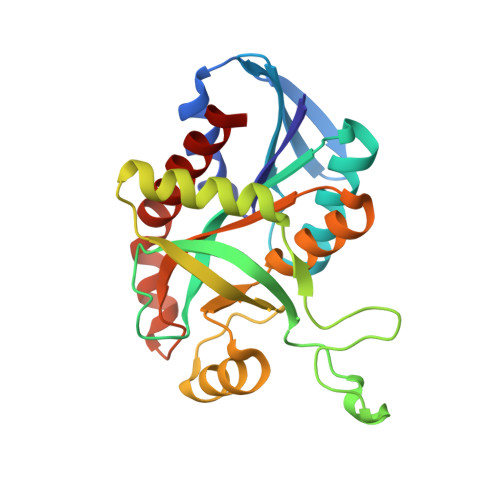Neutron structures of the Helicobacter pylori 5'-methylthioadenosine nucleosidase highlight proton sharing and protonation states.
Banco, M.T., Mishra, V., Ostermann, A., Schrader, T.E., Evans, G.B., Kovalevsky, A., Ronning, D.R.(2016) Proc Natl Acad Sci U S A 113: 13756-13761
- PubMed: 27856757
- DOI: https://doi.org/10.1073/pnas.1609718113
- Primary Citation of Related Structures:
5CCD, 5CCE, 5JPC, 5K1Z, 5KB3 - PubMed Abstract:
MTAN (5'-methylthioadenosine nucleosidase) catalyzes the hydrolysis of the N-ribosidic bond of a variety of adenosine-containing metabolites. The Helicobacter pylori MTAN (HpMTAN) hydrolyzes 6-amino-6-deoxyfutalosine in the second step of the alternative menaquinone biosynthetic pathway. Substrate binding of the adenine moiety is mediated almost exclusively by hydrogen bonds, and the proposed catalytic mechanism requires multiple proton-transfer events. Of particular interest is the protonation state of residue D198, which possesses a pK a above 8 and functions as a general acid to initiate the enzymatic reaction. In this study we present three corefined neutron/X-ray crystal structures of wild-type HpMTAN cocrystallized with S-adenosylhomocysteine (SAH), Formycin A (FMA), and (3R,4S)-4-(4-Chlorophenylthiomethyl)-1-[(9-deaza-adenin-9-yl)methyl]-3-hydroxypyrrolidine (p-ClPh-Thio-DADMe-ImmA) as well as one neutron/X-ray crystal structure of an inactive variant (HpMTAN-D198N) cocrystallized with SAH. These results support a mechanism of D198 pKa elevation through the unexpected sharing of a proton with atom N7 of the adenine moiety possessing unconventional hydrogen-bond geometry. Additionally, the neutron structures also highlight active site features that promote the stabilization of the transition state and slight variations in these interactions that result in 100-fold difference in binding affinities between the DADMe-ImmA and ImmA analogs.
Organizational Affiliation:
Department of Chemistry and Biochemistry, University of Toledo, Toledo, OH 43606.















